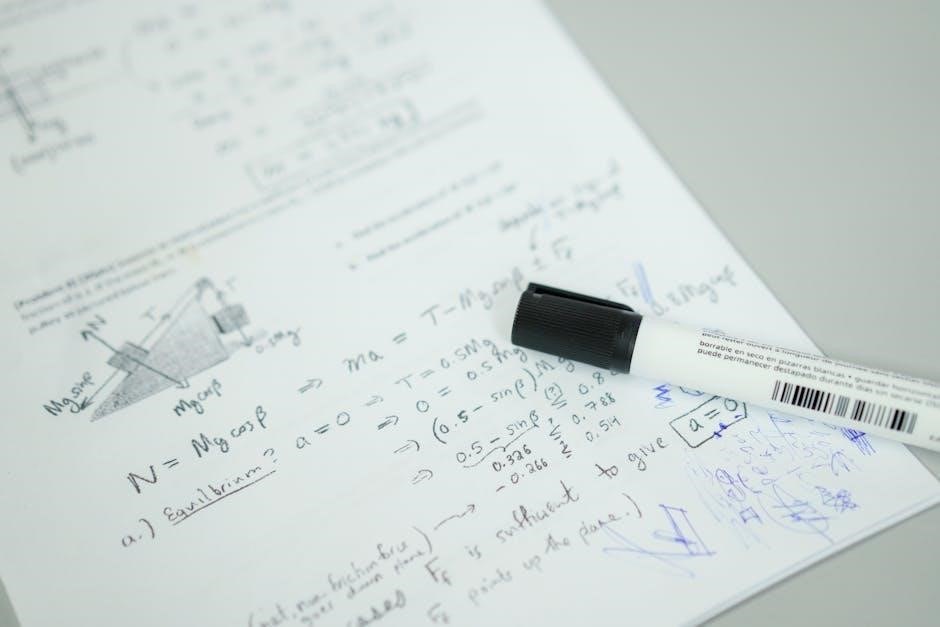Trigonometry studies relationships between angles and sides in right triangles, defining six functions: sine, cosine, tangent, cosecant, secant, and cotangent. Essential for solving problems in various fields.
1.1 Definition and Importance of Trigonometry
Trigonometry is the study of relationships among angles and sides of triangles, particularly right triangles. It defines six trigonometric functions—sine, cosine, tangent, cosecant, secant, and cotangent—using side length ratios. These functions are essential for solving problems in physics, engineering, navigation, and astronomy. Understanding trigonometry is crucial for analyzing periodic phenomena and solving real-world problems involving angles and distances.
1.2 Essential Concepts and Terminology
Trigonometric ratios—sine, cosine, tangent, cosecant, secant, and cotangent—are defined using the side lengths of right triangles. The opposite, adjacent, and hypotenuse sides relative to a reference angle form these ratios. Understanding these concepts is fundamental for solving problems involving angles and sides. Key terminology includes trigonometric functions, reference angles, and the relationships between them, which are essential for mastering trigonometric principles and applications.

Trigonometric Ratios in Right Triangles
Trigonometric ratios—sine, cosine, tangent, and their reciprocals—relate angles to side lengths in right triangles, enabling calculations of unknown sides and angles in various geometric problems.
2.1 Understanding Sine, Cosine, and Tangent
Sine, cosine, and tangent are fundamental trigonometric ratios in right triangles. Sine (sin) is the ratio of the opposite side to the hypotenuse, cosine (cos) is the adjacent side to the hypotenuse, and tangent (tan) is the opposite side to the adjacent side. These ratios enable calculations of unknown sides and angles, making them essential tools for solving geometric and real-world problems in fields like physics and engineering. Mastery of these basics is crucial for advancing in trigonometry.
2.2 Reciprocal Functions: Cosecant, Secant, and Cotangent
Cosecant (csc), secant (sec), and cotangent (cot) are reciprocal functions of sine, cosine, and tangent, respectively. Cosecant is the reciprocal of sine, secant of cosine, and cotangent of tangent. These functions simplify calculations in problems where the original ratios are fractions. They are essential in advanced trigonometric applications, such as solving equations and analyzing periodic phenomena, making them powerful tools in mathematics and related fields like physics and engineering.

Solving Right Triangles
Use trigonometric ratios to find unknown sides and angles, applying inverse functions to determine angles when sides are known, essential for solving right triangle problems effectively.
3.1 Finding Unknown Sides Using Trigonometric Ratios
Trigonometric ratios, such as sine, cosine, and tangent, are used to find unknown sides in right triangles. By identifying the known side and angle, you can set up equations using these ratios. For example, if the opposite side and hypotenuse are known, use sine (opposite/hypotenuse) to find the angle, then apply the ratio to find the adjacent side. This method ensures accurate and efficient problem-solving in right triangle trigonometry.
3;2 Solving for Unknown Angles
To solve for unknown angles, use inverse trigonometric functions. Given two sides of a right triangle, apply the appropriate ratio (sine, cosine, or tangent) and take its inverse. For example, if the opposite and hypotenuse are known, use the inverse sine function to find the angle. This method ensures accurate angle measurement, crucial for applications in physics, engineering, and navigation where precise trigonometric calculations are essential.

Inverse Trigonometric Functions
Inverse trigonometric functions, like arcsin, arccos, and arctan, reverse the original trigonometric ratios, allowing calculation of angles from known side lengths, essential for solving complex equations.
4.1 Understanding Inverse Sine, Cosine, and Tangent
Inverse sine (arcsin), inverse cosine (arccos), and inverse tangent (arctan) functions revert the original trigonometric ratios. They allow determination of an angle when the ratio of sides is known. These functions are crucial for solving equations where angles need to be found from side lengths. Understanding their domains and ranges is essential for accurate calculations and applications in various fields like physics and engineering. Regular practice helps in mastering these concepts effectively.
4.2 Solving Equations with Inverse Trigonometric Functions
Solving equations with inverse trigonometric functions involves isolating the function and applying algebraic techniques. Sketching graphs helps visualize solutions. For example, arcsin(x) requires understanding its domain and range. Squaring both sides or using trigonometric identities can simplify equations. Always verify solutions, as inverse functions may introduce extraneous results. Practice and knowing real-world applications enhance mastery of these problem-solving strategies.

Effective Strategies for Learning Trigonometry
Master trigonometry by using graphing tools, visualization, and problem-solving techniques. Regular practice, understanding real-world applications, and breaking problems into steps enhance learning and retention effectively.
5.1 Problem-Solving Techniques and Tools
Effective strategies include using trigonometric ratios, inverse functions, and algebraic techniques. Sketching graphs, working backward, and applying identities simplify solving equations. Visual aids like diagrams and software enhance understanding. Regular practice with exercises and real-world applications strengthens problem-solving skills. Utilizing study guides and intervention materials provides structured support for mastering trigonometric concepts and retaining key formulas.
5.2 Using Graphing and Visualization to Understand Concepts
Graphing and visualization are powerful tools for understanding trigonometric relationships. By sketching graphs of trigonometric functions, students can identify patterns and periodicity. Drawing detailed diagrams of right triangles helps visualize side ratios and angles. Using geometrical software, like GeoGebra, enhances learning by connecting abstract concepts to real-world shapes. These visual aids make complex relationships clearer, aiding in problem-solving and retention of key formulas and identities.

Real-World Applications of Trigonometry
6.1 Trigonometry in Physics and Engineering
Trigonometry is essential in physics for analyzing wave functions and circular motion, and in engineering for designing bridges and processing signals effectively every day.
Trigonometry is fundamental in physics for analyzing wave functions and circular motion, while in engineering, it aids in designing structures like bridges and processing signals. These applications rely on trigonometric ratios and functions to solve complex problems, demonstrating its practical importance in real-world scenarios and problem-solving across diverse scientific and technical fields every day.
6.2 Practical Uses in Navigation and Astronomy
Trigonometry is crucial in navigation for determining distances, directions, and positions using triangulation. In astronomy, it calculates celestial object positions, orbits, and distances. Trigonometric functions like sine and cosine help analyze wave patterns in ocean currents and planetary motions, essential for accurate predictions and mappings in both fields, showcasing its vital role in understanding and exploring our world and universe through precise mathematical applications every day.

Common Mistakes and Misconceptions
Trigonometry learners often make calculation errors and misapply identities. Misunderstanding angle measures and inverse functions are common. Double-checking work and using visualization tools help avoid these mistakes;
7.1 Avoiding Errors in Trigonometric Calculations
Common errors in trigonometric calculations often stem from incorrect labeling of sides or misapplying identities. To avoid these, always verify angle measures and use algebraic techniques like isolating trigonometric expressions. Sketching graphs or using tools like graphing calculators can help visualize problems. Double-checking calculations and simplifying step-by-step reduces mistakes. Understanding the context of angles (degrees or radians) is crucial. Regular practice and reviewing foundational concepts also minimize errors in trigonometric problem-solving.
7.2 Understanding and Correcting Misconceptions
Common misconceptions in trigonometry often involve confusing sine and cosine or misapplying identities. To address these, use visual aids like graphs to clarify function relationships. Break problems into smaller steps, focusing on angle-side relationships. Regularly reviewing foundational concepts, such as the unit circle and right triangle definitions, helps resolve misunderstandings. Engaging with guided examples and seeking feedback ensures accurate understanding and effective correction of misconceptions.
Reviewing trigonometry involves consolidating key formulas, understanding relationships between angles and sides, and applying inverse functions. Regular practice and self-assessment ensure mastery of trigonometric concepts and problem-solving skills.
8.1 Key Concepts and Formulas

Mastering trigonometry requires understanding sine, cosine, and tangent ratios, as well as their reciprocals. Key formulas include the Pythagorean identity and inverse function relationships. Regular practice reinforces these concepts, ensuring proficiency in solving triangles and equations. Understanding these foundational elements is crucial for advancing in trigonometry and applying it to real-world problems effectively.
8.2 Self-Assessment and Practice Exercises
Regular self-assessment and practice are vital for mastering trigonometry. Use worksheets, online tools, and textbooks to engage with exercises. Start with basic ratio problems, then progress to solving triangles and equations. Graphing calculators can visualize concepts. Track progress, identify weaknesses, and revisit challenging topics. Consistent practice reinforces understanding and builds problem-solving confidence, ensuring readiness for advanced applications of trigonometric principles.

Additional Resources and References
Explore recommended study guides, textbooks, and online tools for trigonometry. Utilize video tutorials and interactive exercises to enhance learning and problem-solving skills effectively.
9.1 Recommended Study Guides and Textbooks
For in-depth learning, consider the 8-4 Study Guide and Intervention Trigonometry, which provides detailed explanations and exercises. Textbooks like Algebra and Trigonometry by Robert Blitzer and Glencoe Algebra offer comprehensive coverage. Additionally, MCGRAW-HILL’S 500 COLLEGE ALGEBRA AND TRIGONOMETRY is an excellent resource for practice problems and conceptual clarity. These materials are designed to support students in mastering trigonometric concepts and applications;
- 8-4 Study Guide and Intervention Trigonometry
- Algebra and Trigonometry by Robert Blitzer
- Glencoe Algebra
- MCGRAW-HILL’S 500 COLLEGE ALGEBRA AND TRIGONOMETRY
9.2 Online Tools and Tutorials for Trigonometry
Enhance your learning with online tools like Khan Academy and GeoGebra, offering interactive lessons and visualizations. Platforms such as Desmos provide graphing tools to explore trigonometric functions. Additionally, video tutorials on YouTube and Coursera courses can deepen your understanding. Utilize these resources to practice problem-solving and gain real-world insights into trigonometry applications.
- Khan Academy
- GeoGebra
- Desmos
- YouTube Tutorials
- Coursera Courses